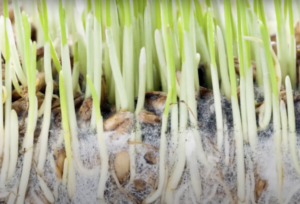High-throughput stable isotope probing helps ID novel interactions between bacteria and fungi

A speedier way to study microbes has been successfully applied to study the hyphosphere, the area immediately surrounding fungi’s long filaments, or hyphae. (Screenshot from Microbiome video abstract for Nuccio EE et al.)
The Science
Researchers have successfully automated aspects of a commonly-used process for studying microbial communities, with results published in the November 2022 issue of Microbiome. High-throughput stable isotope probing (SIP) proved to vastly reduce labor and improve results. Applying this method to the study of a particular fungi, researchers identified novel interactions between bacteria and the fungi.
The Impact
Stable isotope probing is a long and laborious process — as well as a key way scientists study microorganisms. Because microorganisms live in complex communities, like within soils or the gut, they are difficult to study individually. Many microorganisms hold clues to processes like biodegradation, with potential applications in industry and biotechnology for the production of clean energy.
Summary
Arbuscular mycorrhizal fungi, the most widespread type of mycorrhizal fungi, live within a plant’s root system. They form mutually beneficial relationships with over 80% of land plants, which means they offer a lot of insights into how plant materials can be broken down for things like biomass and biofuels. However, AMF and the microbial communities they inhabit are notoriously difficult to study, due to the difficulty replicating the individual compositions of these unique communities.
SIP is an effective way of studying these communities. The process involves “labeling” a given substance by applying a stable isotope to it. The isotopes are incorporated into the DNA of specific microbes who consume the labeled food or water. Later, their DNA can be tested for the isotope, which tells researchers which microorganisms used the labeled substance and which microbes did not.
This is normally an arduous wet lab process. Typically, after incubating microbial communities with labeled food or water, the microbial DNA is manually separated into a few different groups based on its density — DNA containing isotopes is “heavier” than DNA lacking isotopes. This manual collection of DNA is time consuming, tedious and potentially error prone, which limits the size and complexity of research studies that use SIP.
Researchers at Lawrence Livermore National Laboratory and the U.S. Department of Energy Joint Genome Institute, a DOE Office of Science User Facility at Lawrence Berkeley National Laboratory, have developed a semi-automated pipeline to apply robotics to the process.
This automation lets researchers study more samples and provides better resolution by splitting the DNA into more density fractions. It also limits the potential for human error that might compromise samples. In addition, high-throughput SIP places samples into standardized microwell plates, allowing them to be processed at a larger scale through downstream DNA purification and sequencing steps. Ultimately, researchers found their updated strategy required one-sixth the labor of the manual process, allowing them to process dozens of samples simultaneously.
Soil microorganisms play a critical role in sequestering carbon and mitigating greenhouse gas emissions, and understanding how to improve soil health can help mitigate the effects of climate change. The team’s study used samples from the area immediately surrounding AMF’s long filaments, or hyphae. This region is called the hyphosphere. By studying its microbial communities, scientists can better understand how the fungi interacts with them.
In this case, scientists identified a wide variety of microbes, including both bacteria and archaea, actively engaging with the fungi — highlighting the hyphosphere as an even more complex and dynamic environment. By further streamlining the process for studying such microbial communities, HT-SIP ramps up the pace at which researchers can extract the bioenergy secrets they hold.
HT-SIP is a capability available to request through the JGI proposal calls.
Contacts
BER Contact
Ramana Madupu, Ph.D
Program Manager
Biological Systems Sciences Division
Office of Biological and Environmental Research
Office of Science
Department of Energy
Ramana.Madupu@science.doe.gov
PI Contact
Jennifer Pett-Ridge
Lawrence Livermore National Laboratory
pettridge2@llnl.gov
JGI Contact
Rex Malmstrom
Microscale Applications Group Lead
DOE Joint Genome Institute
rrmalmstrom@lbl.gov
Funding
Work at Lawrence Livermore National Laboratory was conducted under the auspices of the U.S. DOE under Contract DE-AC52-07NA27344. The work conducted by the U.S. Department of Energy Joint Genome Institute (https://ror.org/04xm1d337), a DOE Office of Science User Facility, is supported by the Office of Science of the U.S. Department of Energy operated under Contract No. DE-AC02-05CH11231.
Publications
Nuccio, E.E. et al. “HT-SIP: a semi-automated stable isotope probing pipeline identifies cross-kingdom interactions in the hyphosphere of arbuscular mycorrhizal fungi.” Microbiome, 10, 199 (2022). doi:10.1186/s40168-022-01391-z
Related Links
- Video: Erin Nuccio at the 2021 JGI Annual Meeting
- JGI Engagement Webinar: SIP technologies at EMSL and JGI
- JGI Genome Insider podcast episode: A Powerful Technique to Study Microbes, Now Easier
- JGI Genome Insider podcast episode: Party in the Rhizosphere